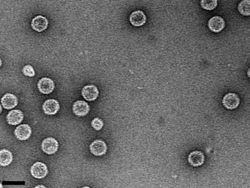Biology:Picobirnavirus
| Picobirnavirus | |
|---|---|

| |
| Electron micrograph of human picobirnavirus particles | |
| Virus classification | |
| (unranked): | Virus |
| Realm: | Riboviria |
| Kingdom: | Orthornavirae |
| Phylum: | Pisuviricota |
| Class: | Duplopiviricetes |
| Order: | Durnavirales |
| Family: | Picobirnaviridae |
| Genus: | Picobirnavirus |
Picobirnavirus is a genus of double-stranded RNA viruses. It is the only genus in the family Picobirnaviridae.[1] Although amniotes, especially mammals, were thought to serve as hosts, it has been recently suggested that these viruses might infect bacteria and possibly some other invertebrates. If they do infect bacteria, then they are Bacteriophages.[2][3] There are three species in this genus. Associated symptoms include gastroenteritis in animals and humans, though the disease association is unclear.[4][5]
Etymology
Picobirnavirus is a small (pico, Spanish for small), bisegmented (bi, Latin for two), double-stranded RNA virus. Picobirnaviruses were initially considered to be birna-like viruses, and the name was derived from birnavirus (bisegmented RNA), but the virions are much smaller (diameter 35 nm vs. 65 nm). [6] Picobirnaviruses were first detected in humans and black-footed pigmy rice rats in 1988.[7]
Structure
Viruses in the genus are non-enveloped, with icosahedral geometries, and T=3 symmetry. The diameter is around 35–40 nm.[5][4]
Genome
The genome is linear, bipartite, and composed of double-stranded RNA. It includes a segment 1 which is 2.2–2.7 kilobases (kb) in length and a segment 2 which is 1.2–1.9 kb in length. The genome codes for three to four proteins.[4] The capsid protein gene is encoded by the second open reading frame of the larger genomic segment 1.[4]
Picobirnaviruses are divided into two genogroups on the basis of the sequence of segment 2. The RNA-dependent RNA polymerase (RdRp) is encoded by segment 2. The group viruses have been isolated from humans and other mammals, as well as birds and squamates.[8]
Life cycle

Picobirnaviruses target intestine tissue. Entry into the host cell is achieved by penetration into the host cell. Once in the host cell, viral replication is cytoplasmic. Replication follows the double-stranded RNA virus replication model. Double-stranded RNA virus transcription is the method of transcription. The viruses are released from the cell by budding. Mammals serve as the natural host. Transmission routes are fecal-oral.[5][4]
Taxonomy
Picobirnaviruses were initially thought to belong to the family Birnaviridae, but later were confirmed to differ with respect to host, virion size, capsid, RNA-dependent RNA polymerase, genome size, and organization.[9] The family Picobirnaviridae is now classified distinctly and composed of one genus Picobirnavirus, which has three species:[10]
- Beihai picobirnavirus
- Equine picobirnavirus
- Human picobirnavirus
References
- ↑ Delmas, B; Attoui, H; Ghosh, S; Malik, YS; Mundt, E; Vakharia, VN; Ictv Report, Consortium (February 2019). "ICTV virus taxonomy profile: Picobirnaviridae.". The Journal of General Virology 100 (2): 133–134. doi:10.1099/jgv.0.001186. PMID 30484763.
- ↑ Krishnamurthy, Siddharth R.; Wang, David (1 March 2018). "Extensive conservation of prokaryotic ribosomal binding sites in known and novel picobirnaviruses". Virology 516: 108–114. doi:10.1016/j.virol.2018.01.006. ISSN 0042-6822. PMID 29346073.
- ↑ Yinda, Claude Kwe; Ghogomu, Stephen Mbigha; Conceição-Neto, Nádia; Beller, Leen; Deboutte, Ward; Vanhulle, Emiel; Maes, Piet; Van Ranst, Marc et al. (January 2018). "Cameroonian fruit bats harbor divergent viruses, including rotavirus H, bastroviruses, and picobirnaviruses using an alternative genetic code". Virus Evolution 4 (1): vey008. doi:10.1093/ve/vey008. ISSN 2057-1577. PMID 29644096.
- ↑ 4.0 4.1 4.2 4.3 4.4 "Viral Zone". ExPASy. http://viralzone.expasy.org/all_by_species/602.html.
- ↑ 5.0 5.1 5.2 "ICTV Report: Picobirnaviridae". http://www.ictv.global/report/picobirnaviridae.
- ↑ Malik, Yashpal S.; Ghosh, Souvik (January 2020). "Etymologia: Picobirnavirus". Emerging Infectious Diseases 26 (1): 89. doi:10.3201/eid2601.et2601.
- ↑ Pereira, HG; Flewett, TH; Candeias, JAN; Barth, OM (1988). "A virus with a bisegmented double-stranded RNA genome in rat (Oryzomys nigripes) intestines". J Gen Virol 69 (11): 2749–2754. doi:10.1099/0022-1317-69-11-2749. PMID 3053986.
- ↑ Smits, SL; van Leeuwen, M; Schapendonk, CM; Schürch, AC; Bodewes, R; Haagmans, BL; Osterhaus, AD (2012). "Picobirnaviruses in the human respiratory tract". Emerging Infectious Diseases 18 (9): 1539–40. doi:10.3201/eid1809.120507. PMID 22932227.
- ↑ Malik, YS; Kumar, N; Sharma, K; Dhama, K; Shabbir, MZ; Ganesh, B; Kobayashi, N; Banyai, K (2014). "Epidemiology, phylogeny, and evolution of emerging enteric Picobirnaviruses of animal origin and their relationship to human strains". Biomed Res. Int. 2014: 1–13. doi:10.1155/2014/780752. PMID 25136620.
- ↑ "International Committee on Taxonomy of Viruses (ICTV)" (in en). https://ictv.global/taxonomy.
External links
- Malik, YS (2014). "Epidemiology, phylogeny, and evolution of emerging enteric Picobirnaviruses of animal origin and their relationship to human strains". Biomed Res Int 2014: 1–13. doi:10.1155/2014/780752. PMID 25136620.
- Chandra, R (1997). "Picobirnavirus, a novel group of undescribed viruses of mammals and birds: A minireview". Acta Virologica 41 (1): 59–62. PMID 9199719.
- Rosen, B; Fang, ZY; Glass, RI; Monroe, SS (2000). "Cloning of Human Picobirnavirus Genomic Segments and Development of an RT-PCR Detection Assay". Virology 277 (2): 316–29. doi:10.1006/viro.2000.0594. PMID 11080479.
- Taxonomic proposal for picobirnaviridae at the ICTV
- Viralzone: Picobirnavirus
- ICTV Report: Picobirnaviridae
Wikidata ☰ Q7191036 entry
 |


